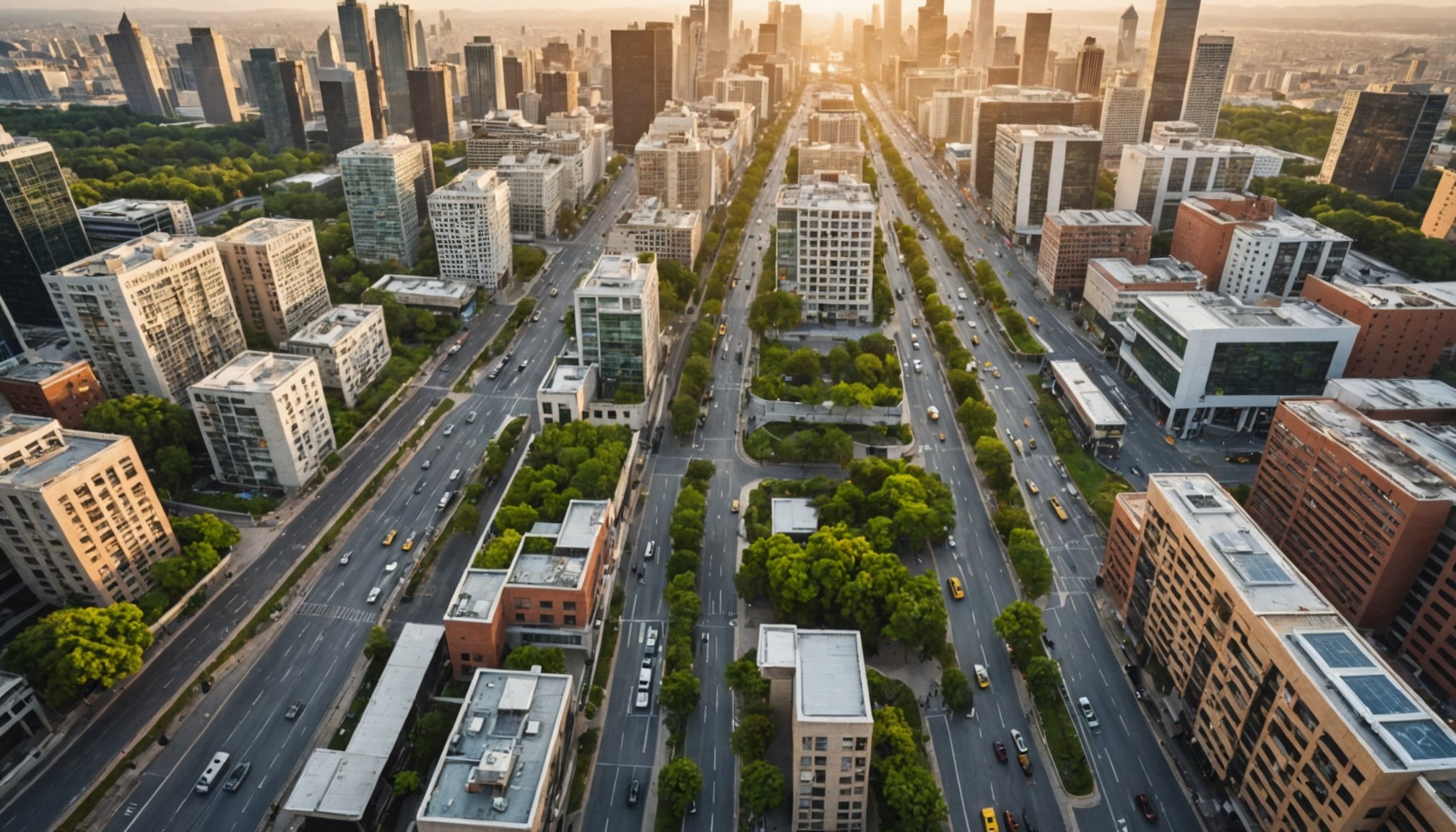Sustainable Solutions for Bustling Cities: A Comprehensive Guide to Low-Impact Development Strategies
As the world grapples with the challenges of rapid urbanization, climate change, and environmental degradation, the need for sustainable urban development has never been more pressing. Cities, which are hubs of economic activity, cultural diversity, and innovation, must also become models of sustainability and environmental stewardship. Here’s a detailed guide on how cities can adopt low-impact development strategies to ensure a sustainable, resilient, and livable future.
The Importance of Sustainable Urban Development
Cities are not just economic powerhouses; they are also significant contributors to environmental issues such as climate change, resource depletion, and biodiversity loss. However, by adopting sustainable urban development strategies, cities can mitigate their environmental impact and enhance the quality of life for their residents.
In parallel : Transforming victorian homes: chic strategies for sustainable energy efficiency
“Sustainable urban development seeks to harmonize economic growth, social inclusion, and environmental stewardship,” explains the concept outlined in the context of sustainable urban development strategies[2].
Key Elements of Regenerative Urban Design
Regenerative urban design is a progressive approach to urban development that focuses on integrating natural systems into urban planning. Here are some key elements to consider:
Additional reading : Revitalizing victorian residences: cutting-edge eco-friendly renovation techniques for sustainable makeovers
Green Infrastructure
Urban planning should emphasize the integration of ecologically managed green and blue spaces. This includes trees, wetlands, green roofs, and other natural elements that support biodiversity, improve climate resilience, and provide recreational spaces.
- Tree Canopy Cover and Distribution: Follow guidelines like the 3-30-300 rule to ensure adequate tree cover and distribution of green spaces.
- Biodiversity Richness: Prioritize native plant species to enhance local ecosystems.
- Heat Stress Reduction: Green spaces can significantly reduce heat stress in urban areas.
- Equitable Access: Ensure that all vulnerable groups have access to these green spaces[1].
Biodiversity, Native Species, & Ecological Restoration
Prioritizing native species in parks and green spaces is crucial for enhancing local ecosystems and supporting higher levels of biodiversity. Efforts to restore degraded lands or waterways can also enhance the city’s ecological health.
- Native Species Coverage: Use native plant species in urban green spaces.
- Control of Invasive Species: Manage and control invasive species that can harm local ecosystems.
- Restoration and Reparation: Restore degraded lands and waterways to their natural state[1].
Building Greenways and Urban Mobility
Greenways are multipurpose paths or strips of land in cities that are protected for environmental or recreational purposes. These green corridors can significantly enhance urban mobility and connectivity between citizens and the natural environment.
Case Studies: San José and Guangzhou
Cities like San José in Costa Rica and Guangzhou in China have successfully implemented greenways to shape urban mobility and build stronger connections between citizens and nature.
- Guangzhou’s Green Infrastructure: Guangzhou’s networks of safer, greener infrastructure have helped reduce carbon dioxide equivalent emissions by about 16,000 tonnes per year, equivalent to planting 3-400,000 new trees annually[3].
Key Considerations for Building Nature-Positive Cities
- Robust Frameworks for Integrating Nature: Policies and guidelines should require a biological approach to development, regeneration, and inclusion across the city.
- Supporting Nature in Mobility Corridors: Design built environments and active mobility corridors that integrate blue-green infrastructure such as trees, woodlands, green roofs, and waterways.
- Interdisciplinary and Participatory Planning: Use collective action from communities and grassroots organizations to inform interventions and shape the city’s political agenda[3].
Sustainable Urban Development Strategies
Sustainable urban development is about creating cities that are resilient, livable, and equitable for all residents while minimizing their ecological footprint. Here are some strategies to achieve this:
Promoting Green Infrastructure
Green infrastructure is a strategically planned network of natural and semi-natural areas designed to deliver a wide range of ecosystem services, including water purification, air quality improvement, and biodiversity enhancement.
| Ecosystem Service | Description |
|---|---|
| Water Purification | Natural systems that filter and clean water. |
| Air Quality Improvement | Green spaces that absorb pollutants and produce oxygen. |
| Biodiversity Enhancement | Habitats that support a variety of plant and animal species. |
| Climate Regulation | Green spaces that mitigate the urban heat island effect and manage stormwater. |
The EU Green Infrastructure Strategy promotes the preservation, restoration, and enhancement of green infrastructure to stop biodiversity loss and enable ecosystems to deliver their services to people[4].
Enhancing Energy Efficiency
Energy efficiency is crucial for reducing the carbon footprint of cities. Here are some strategies:
- Energy-Efficient Buildings: Implement building codes that require energy-efficient design and materials.
- Renewable Energy Sources: Promote the use of renewable energy sources such as solar, wind, and geothermal energy.
- Smart Grids: Develop smart grid systems that optimize energy distribution and consumption.
Fostering Sustainable Transportation
Sustainable transportation options can significantly reduce carbon emissions and improve air quality in cities.
- Public Transportation: Invest in efficient public transportation systems such as buses, trains, and subways.
- Cycling and Walking Infrastructure: Develop safe and accessible cycling and walking paths.
- Electric Vehicles: Encourage the use of electric vehicles through incentives and infrastructure development[2].
Slow Urbanism: A Human-Centered Approach
Slow Urbanism is an intellectual model of urban design that prioritizes quality of life, community, and sustainability over speed and profit.
Key Principles of Slow Urbanism
- Community-Centered Design: Design urban spaces that foster community interaction and a sense of belonging.
- Sustainability: Promote sustainable practices that address environmental problems such as air pollution, resource depletion, and climate change.
- Inclusivity: Ensure that urban development is inclusive and equitable for all residents.
“Slow Urbanism—with its human-centered design, sustainability, and inclusivity—offers a very alluring alternative to the headlong, profit-driven development that all too often characterizes dominant urban planning strategies,” highlights the Slow Urbanism approach[5].
Practical Insights and Actionable Advice
Integrating Nature into Urban Planning
When planning to integrate nature into urban spaces, consider the following:
- Biological Approach: Adopt a biological approach to development, regeneration, and inclusion across the city.
- Stakeholder Participation: Encourage participation from communities and formal grassroots organizations to inform interventions.
- Co-Benefits: Identify co-benefits of integrating nature into urban planning, such as improved air quality, enhanced biodiversity, and increased community engagement[3].
Managing Stormwater and Water Resources
Effective stormwater management is crucial for reducing the impact of urban development on water resources.
- Green Roofs and Rain Gardens: Implement green roofs and rain gardens to manage stormwater runoff.
- Wetlands and Waterways: Restore and preserve wetlands and waterways to maintain natural water cycles.
- Water-Efficient Practices: Promote water-efficient practices in residential and commercial areas[1].
Creating sustainable cities is a multifaceted challenge that requires a holistic approach. By integrating green infrastructure, enhancing energy efficiency, fostering sustainable transportation, and adopting human-centered design principles, cities can mitigate their environmental impact and enhance the quality of life for their residents.
“Sustainable urban development is fundamentally about enhancing the quality of life for urban dwellers. It entails creating vibrant urban spaces that prioritize access to clean air, water, and green spaces, while promoting social cohesion and inclusive growth,” emphasizes the importance of sustainable urban development[2].
As cities continue to grow and evolve, it is imperative that we adopt low-impact development strategies to ensure a resilient, sustainable, and livable future for all.
Detailed Bullet Point List: Strategies for Sustainable Urban Development
-
Promote Green Infrastructure:
-
Integrate ecologically managed green and blue spaces into urban planning.
-
Prioritize native plant species in parks and green spaces.
-
Restore degraded lands and waterways.
-
Enhance Energy Efficiency:
-
Implement energy-efficient building codes.
-
Promote the use of renewable energy sources.
-
Develop smart grid systems.
-
Foster Sustainable Transportation:
-
Invest in efficient public transportation systems.
-
Develop safe and accessible cycling and walking paths.
-
Encourage the use of electric vehicles.
-
Adopt Slow Urbanism Principles:
-
Design urban spaces that foster community interaction and a sense of belonging.
-
Promote sustainable practices that address environmental problems.
-
Ensure that urban development is inclusive and equitable for all residents.
-
Manage Stormwater and Water Resources:
-
Implement green roofs and rain gardens to manage stormwater runoff.
-
Restore and preserve wetlands and waterways to maintain natural water cycles.
-
Promote water-efficient practices in residential and commercial areas.
Comprehensive Table: Benefits of Green Infrastructure
| Benefit | Description |
|---|---|
| Biodiversity Enhancement | Supports a variety of plant and animal species. |
| Air Quality Improvement | Absorbs pollutants and produces oxygen. |
| Water Purification | Filters and cleans water through natural systems. |
| Climate Regulation | Mitigates the urban heat island effect and manages stormwater. |
| Recreational Spaces | Provides areas for physical activity and mental well-being. |
| Economic Benefits | Increases property values and supports local businesses. |
| Social Cohesion | Fosters community interaction and a sense of belonging. |
| Carbon Sequestration | Reduces carbon emissions by absorbing CO2. |
By integrating these strategies and benefits into urban planning, cities can move towards a more sustainable, resilient, and livable future.











